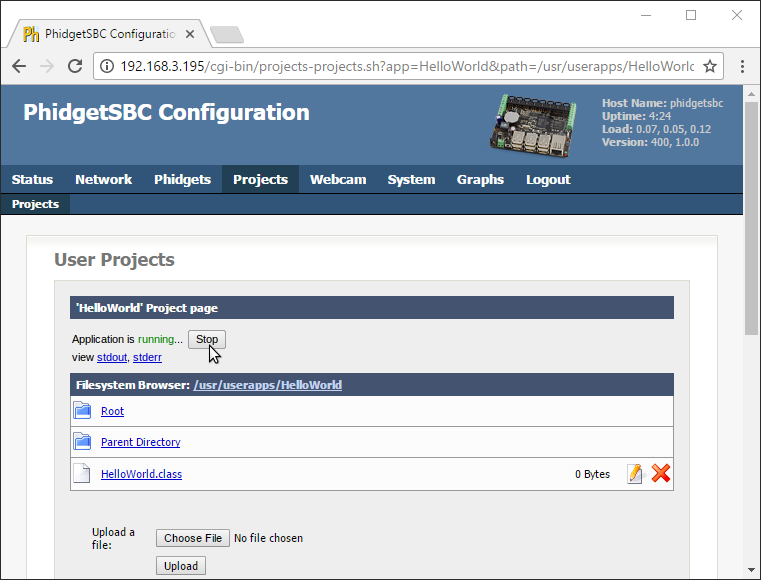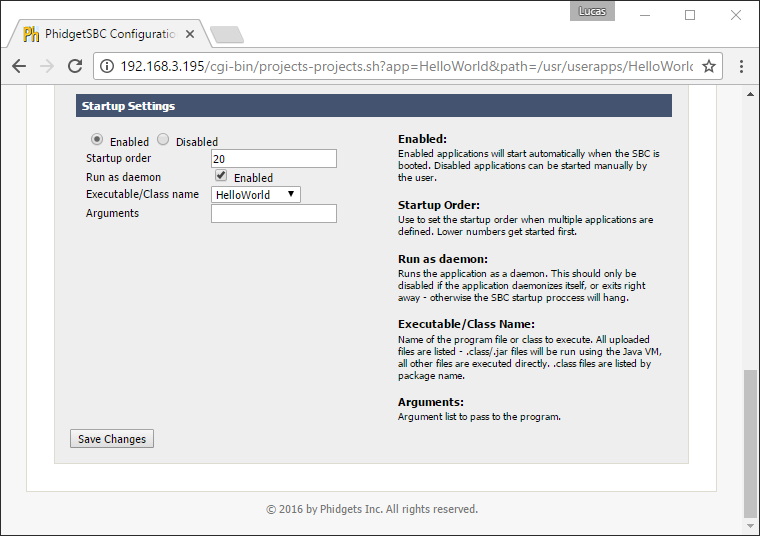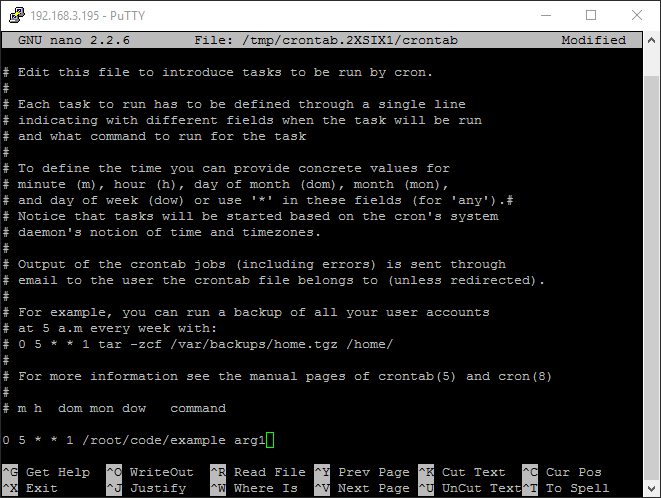|
|
| (11 intermediate revisions by 4 users not shown) |
| Line 1: |
Line 1: |
| | __NOTOC__ |
| [[Category:Language]] | | [[Category:Language]] |
| __TOC__
| | We provide support for the C language in all major operating systems. We also provide instructions on how to get your project started in a number of common development environments. Select your operating system and preferred development environment below, and follow the instructions to get your project running with Phidgets. |
| | |
| | If you do not know which development environment you want to use, or your development environment of choice is not listed, we recommend starting with GCC as the simplest path to getting your code running. |
| | |
| | Once you have set up your development environment to run with Phidgets, we recommend you follow our guide on [[Phidget Programming Basics]]. The guide will showcase the fundamentals of programming with Phidgets, with examples in C. |
| | |
| | == Setup Guide == |
| | |
| | <div class="phd-deck-sequence"> |
| | {{PT3_C_CHOOSE}}{{PT3_C_WIN_VS}}{{PT3_C_WIN_VS_1}}{{PT3_C_WIN_VS_2}}{{PT3_C_WIN_CB}} |
| | {{PT3_C_WIN_GCC}}{{PT3_C_MAC_GCC}}{{PT3_C_LNX_GCC}}{{PT3_C_SBC_GCC}} |
| | </div> |
| | |
|
| |
|
| == Quick Downloads == | | == Quick Downloads == |
| | |
| | If you already know what you're doing and just need the files, you can find them all below. |
|
| |
|
| === Documentation === | | === Documentation === |
| Line 10: |
Line 25: |
| === Example Code === | | === Example Code === |
|
| |
|
| *{{SampleCode|C|C/C++ Examples}} | | *{{SampleCode|C|C Examples}} |
|
| |
|
| ===Libraries=== | | ===Libraries=== |
|
| |
|
| {{AllQuickDownloads}} | | {{AllQuickDownloads}} |
|
| |
| == Getting started with C/C++ ==
| |
| Welcome to using Phidgets with C/C++! By using C/C++, you will have access to the complete Phidget22 API, including events. We also provide example code in C/C++ for all Phidget devices.
| |
|
| |
| If you are developing for Windows, keep reading. Otherwise, select your operating system to jump ahead:
| |
| *[[#macOS | macOS]]
| |
| *[[#Linux | Linux]]
| |
|
| |
| == Windows ==
| |
| {{Windows_Languages}}
| |
|
| |
| ===Visual Studio===
| |
| ====Use our examples====
| |
| One of the best ways to start programming with Phidgets is to use our example code as a guide. In order to run the examples, you will need to download and install [https://www.visualstudio.com/ Microsoft Visual Studio].
| |
|
| |
|
| |
| Now that you have Microsoft Visual Studio installed, select an example that will work with your Phidget:
| |
| *{{SampleCode|C|C/C++ Examples}}
| |
|
| |
|
| |
| Open the example project and start the example by pressing the ''Local Windows Debugger'' button:
| |
|
| |
|
| |
| [[Image: c_vs_run.png|link=|center]]
| |
|
| |
|
| |
| The application will open the Phidget, list basic information about the Phidget, and demonstrate the Phidget's functionality. Here is an example of an Accelerometer channel on a Spatial Phidget:
| |
|
| |
|
| |
| [[Image: c_vs_output.PNG|link=|center]]
| |
|
| |
|
| |
| You should now have the example up and running for your device. Play around with the device and experiment with some of the functionality. When you are ready, the next step is configuring your project and writing your own code!
| |
|
| |
| ====Configure your project====
| |
| When you are building a project from scratch, or adding Phidget functionality to an existing project, you'll need to configure your development environment to properly link the Phidget C/C++ library. To begin:
| |
|
| |
|
| |
| Create a new Win32 Console application:
| |
|
| |
| [[Image:C_vs_newproject.PNG|link=|center]]
| |
|
| |
|
| |
| After creating a project with the default settings, access the project's properties:
| |
|
| |
| [[Image:C_vs_properties.png|link=|center]]
| |
|
| |
|
| |
| Next, navigate to Configuration Properties -> C/C++ -> General and add the following line to the additional include directories:
| |
| *C:\Program Files\Phidgets\Phidget22
| |
|
| |
|
| |
| [[Image:C_vs_additionalinclude.png|link=|center]]
| |
|
| |
|
| |
| Navigate to Configuration Properties -> Linker -> Input and add the following line to the additional dependencies:
| |
| *C:\Program Files\Phidgets\Phidget22\phidget22.lib
| |
|
| |
|
| |
| [[Image:C_vs_additionadepend.png|link=|center]]
| |
|
| |
| Finally, include the Phidget library in your code:
| |
|
| |
| <syntaxhighlight lang='C'>
| |
| #include <phidget22.h>
| |
| </syntaxhighlight>
| |
|
| |
| Success! The project now has access to Phidgets. Next, view the [[#Write Code | write your own code]] section located below.
| |
|
| |
| ===GCC===
| |
| ====Cygwin/MinGW====
| |
| =====Use our examples=====
| |
| One of the best ways to start programming with Phidgets is to use our example code as a guide. In order to run the examples, you will need to download and install either [http://www.mingw.org/ MinGW] or [https://www.cygwin.com/ Cygwin].
| |
|
| |
|
| |
| Now that you have either MinGW or Cygwin installed, select an example that will work with your Phidget:
| |
| *{{SampleCode|C|C/C++ Examples}}
| |
|
| |
|
| |
| If you are using Cygwin, navigate to the folder where the example is and open the command prompt. Enter the following command to compile the example:
| |
| <syntaxhighlight lang='bash'>
| |
| gcc example.c -o example -I"/cygdrive/c/Program Files/Phidgets/Phidget22" -L"/cygdrive/c/Program Files/Phidgets/Phidget22/x86" -lphidget22
| |
| </syntaxhighlight>
| |
|
| |
|
| |
| If you are using MinGW, navigate to the folder where the example is and open the command prompt. Enter the following command to compile the example:
| |
| <syntaxhighlight lang='bash'>
| |
| gcc example.c -o example -I"C:/Program Files/Phidgets/Phidget22" -L"C:/Program Files/Phidgets/Phidget22/x86" -lphidget22
| |
| </syntaxhighlight>
| |
|
| |
| After running the commands above for either Cygwin or MinGW, an executable file called ''example.exe'' will be created. Enter the following command to run the example:
| |
| <syntaxhighlight lang='bash'>
| |
| example.exe
| |
| </syntaxhighlight>
| |
|
| |
|
| |
| You should now have the example up and running. When you are ready, the next step is configuring your project and writing your own code!
| |
|
| |
| =====Configure your project=====
| |
| When you are building a project from scratch, or adding Phidget functionality to an exisiting project, you'll need to configure your development environment to properly link the Phidget C/C++ library.
| |
|
| |
| To include the Phidget C/C++ library, add the following line to your code:
| |
| <syntaxhighlight lang='C'>
| |
| #include <phidget22.h>
| |
| </syntaxhighlight>
| |
|
| |
| You can now compile the file as shown in the previous section.
| |
|
| |
|
| |
| The project now has access to Phidgets. Next, view the [[#Write Code | write your own code]] section located below.
| |
|
| |
| ===Code::Blocks===
| |
| ====Use our examples====
| |
| One of the best ways to start programming with Phidgets is to use our example code as a guide. In order to run the examples, you will need to download and install [http://www.codeblocks.org/downloads Code::Blocks].
| |
|
| |
|
| |
| Now that you have Code::Blocks installed, select an example that will work with your Phidget:
| |
| *{{SampleCode|C|C/C++ Examples}}
| |
|
| |
|
| |
| Open the example in Code::Blocks (you do not need to create a new project) and navigate to Settings -> Compiler... as shown in the image below:
| |
|
| |
| [[Image:C_codeblocks_settings.png|link=|center]]
| |
|
| |
|
| |
| From the Global compiler settings screen, navigate to Search directories -> Compiler and add the following directory:
| |
| *C:\Program Files\Phidgets\Phidget22
| |
|
| |
| [[Image:C_codeblocks_compiler.PNG|link=|center]]
| |
|
| |
|
| |
| Next, select Search directories -> Linker and add the following directory:
| |
| *C:\Program Files\Phidgets\Phidget22\x86
| |
|
| |
| [[Image:C_codeblocks_linker.PNG|link=|center]]
| |
|
| |
|
| |
| Finally, from the Global compiler settings screen, navigate to Linker settings and add the following line:
| |
| *phidget22
| |
|
| |
| [[Image:C_codeblocks_libraries.PNG|link=|center]]
| |
|
| |
|
| |
| You can now build and run the example:
| |
|
| |
| [[Image:C_codeblocks_run.png|link=|center]]
| |
|
| |
|
| |
| You should now have the example up and running for your device. Play around with the device and experiment with some of the functionality. When you are ready, the next step is configuring your project and writing your own code!
| |
|
| |
| ====Configure your project====
| |
| When you are building a project from scratch, or adding Phidget functionality to an existing project, you'll need to configure your development environment to properly link the Phidget C/C++ library.
| |
|
| |
|
| |
| To include the Phidget C/C++ library, add the following line to your code:
| |
| <syntaxhighlight lang='C'>
| |
| #include <phidget22.h>
| |
| </syntaxhighlight>
| |
|
| |
| You can now compile the file as shown in the previous section.
| |
|
| |
|
| |
| The project now has access to Phidgets. Next, view the [[#Write Code | write your own code]] section located below.
| |
|
| |
| ==macOS==
| |
| {{macOS_Languages}}
| |
| ===GCC===
| |
| ====Use our examples====
| |
| One of the best ways to start programming with Phidgets is to use our example code as a guide. You likely have gcc installed on your macOS machine already, but if not, you can easily get it by downloading [https://developer.apple.com/xcode/ Xcode].
| |
|
| |
| Next, select an example that will work with your Phidget:
| |
| *{{SampleCode|C|C/C++ Examples}}
| |
|
| |
|
| |
| To compile the example program, enter the following command in the terminal:
| |
| <syntaxhighlight lang='bash'>
| |
| gcc example.c -o example -F /Library/Frameworks -framework Phidget22 -I /Library/Frameworks/Phidget22.framework/Headers
| |
| </syntaxhighlight>
| |
|
| |
| Finally, run the program by entering the following command in the terminal:
| |
| <syntaxhighlight lang='bash'>
| |
| ./example
| |
| </syntaxhighlight>
| |
|
| |
|
| |
| [[Image:c_mac_gcc.png|link=|center]]
| |
|
| |
|
| |
| You should now have the example up and running for your device. Play around with the device and experiment with some of the functionality. When you are ready, the next step is configuring your project and writing your own code!
| |
|
| |
| ====Configure your project====
| |
| When you are building a project from scratch, or adding Phidget functionality to an exisiting project, you'll need to configure your development environment to properly link the Phidget C/C++ library.
| |
|
| |
| To include the Phidget C/C++ library, simply add the following line to your code:
| |
| <syntaxhighlight lang='C'>
| |
| #include <phidget22.h>
| |
| </syntaxhighlight>
| |
|
| |
| You can now compile the file as shown in the previous section.
| |
|
| |
|
| |
| The project now has access to Phidgets. Next, view the [[#Write Code | write your own code]] section located below.
| |
|
| |
| ==Linux==
| |
| {{Linux_Languages}}
| |
| ===GCC===
| |
| ====Use our examples====
| |
| One of the best ways to start programming with Phidgets is to use our example code as a guide. You likely have gcc installed on your Linux machine already, but if not, you can easily get it by entering the following command in the terminal:
| |
| <syntaxhighlight lang='C'>
| |
| apt-get install gcc
| |
| </syntaxhighlight>
| |
|
| |
|
| |
| Next, select an example that will work with your Phidget:
| |
| *{{SampleCode|C|C/C++ Examples}}
| |
|
| |
|
| |
| To compile the example, enter the following command in the terminal:
| |
|
| |
| <syntaxhighlight lang='bash'>
| |
| gcc example.c -o example -lphidget22
| |
| </syntaxhighlight>
| |
|
| |
| After compiling, you can run the program by entering the following command in the terminal:
| |
| <syntaxhighlight lang='bash'>
| |
| ./example
| |
| </syntaxhighlight>
| |
|
| |
|
| |
| You should now have the example up and running. When you are ready, the next step is configuring your project and writing your own code!
| |
|
| |
| ====Configure your project====
| |
| When you are building a project from scratch, or adding Phidget functionality to an exisiting project, you'll need to configure your development environment to properly link the Phidget C/C++ library.
| |
|
| |
| To include the Phidget C/C++ library, simply add the following line to your code:
| |
| <syntaxhighlight lang='C'>
| |
| #include <phidget22.h>
| |
| </syntaxhighlight>
| |
|
| |
| You can now compile the file as shown in the previous section.
| |
|
| |
|
| |
| The project now has access to Phidgets. Next, view the [[#Write Code | write your own code]] section located below.
| |
|
| |
| ==Write Code==
| |
| You've followed the instructions above for your operating system and now have a working example. Next, we will show you how the example was created and how it works by getting into the code. When you are ready, head to our [[Phidget Programming Basics]] page. There you will find code examples writen in C/C++ and you will be writing your own code in no time!
| |
|
| |
| == Further Reading ==
| |
|
| |
| [[Phidget Programming Basics]] - Here you can find the basic concepts to help you get started with making your own programs that use Phidgets.
| |
|
| |
| [[Data Interval/Change Trigger]] - Learn about these two properties that control how much data comes in from your sensors.
| |
|
| |
| [[Using Multiple Phidgets]] - It can be difficult to figure out how to use more than one Phidget in your program. This page will guide you through the steps.
| |
|
| |
| [[Polling vs. Events]] - Your program can gather data in either a polling-driven or event-driven manner. Learn the difference to determine which is best for your application.
| |
|
| |
| [[Logging, Exceptions, and Errors]] - Learn about all the tools you can use to debug your program.
| |
|
| |
| [[Phidget Network Server]] - Phidgets can be controlled and communicated with over your network- either wirelessly or over ethernet.
| |




